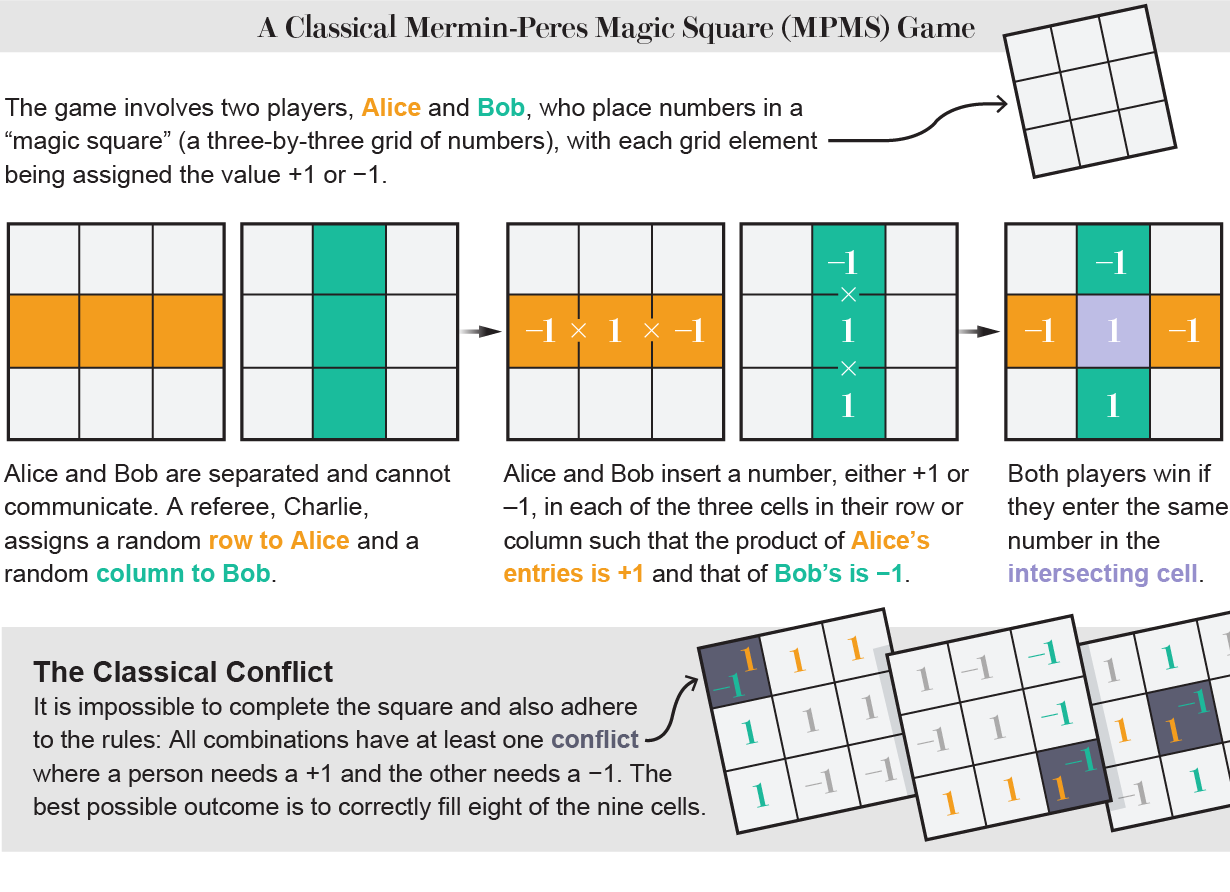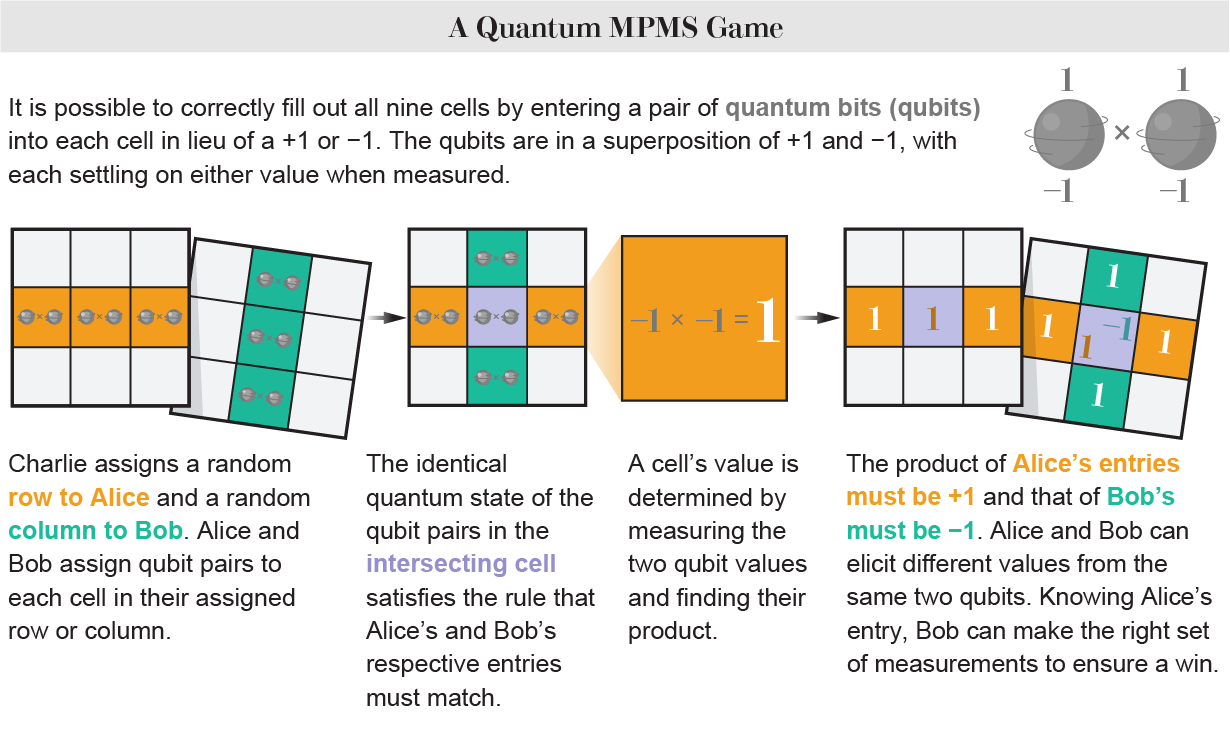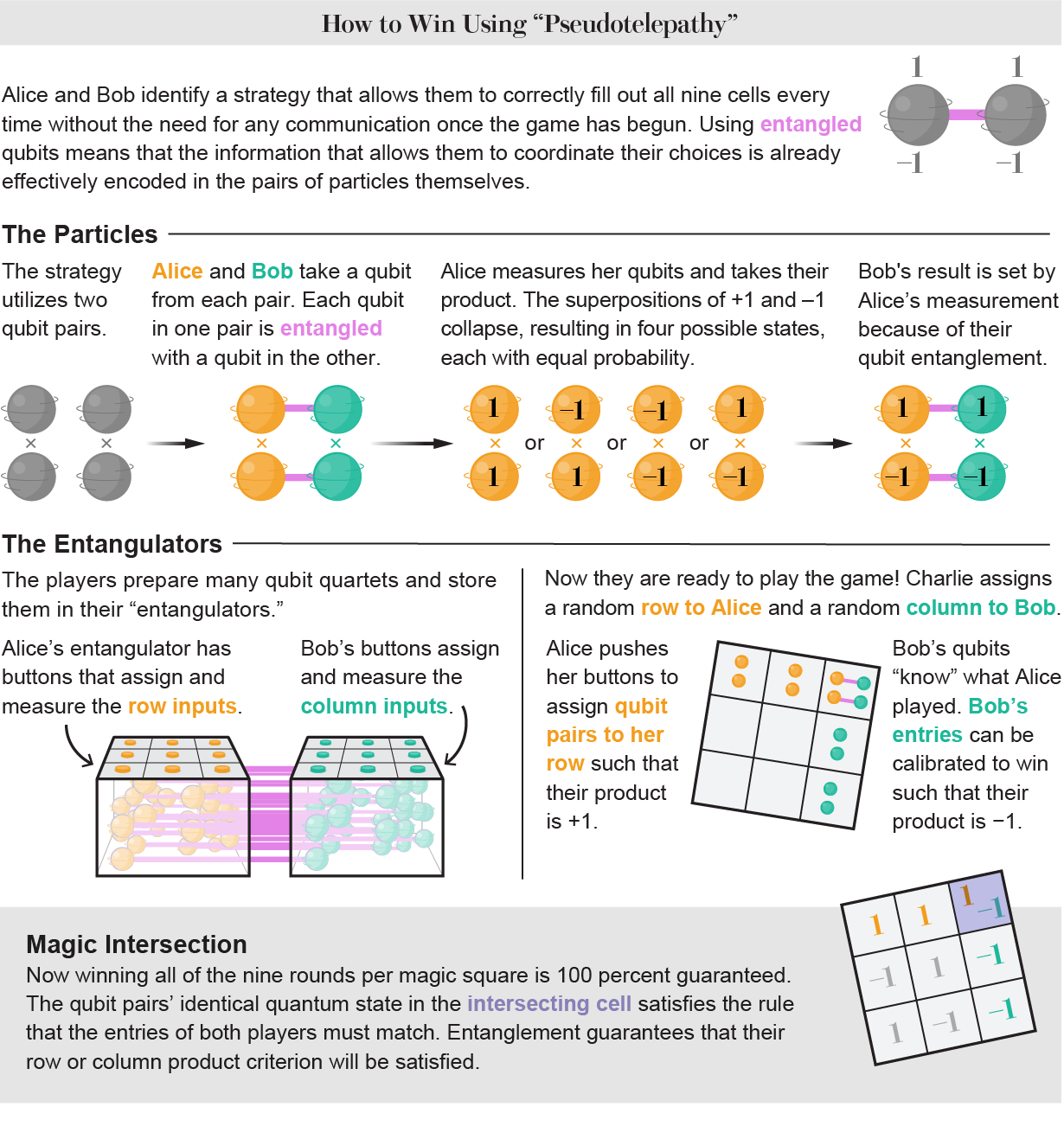To win at the card game of bridge, which is played between two sets of partners, one player must somehow signal to their teammate the strength of the hand they hold. Telepathy would come in handy here. But telepathy isn’t real, right?
That’s correct. For decades, however, physicists have suspected that if bridge were played using cards governed by the rules of quantum mechanics, something that looks uncannily like telepathy should be possible. Now researchers in China have experimentally demonstrated this so-called quantum pseudotelepathy—not in quantum bridge but in a two-player quantum competition called the Mermin-Peres magic square (MPMS) game, where winning requires that the players coordinate their actions without exchanging information with each other. Used judiciously, quantum pseudotelepathy allows the players to win each and every round of the game—a flawless performance that would otherwise be impossible. The experiment, conducted using laser photons, probes the limits of what quantum mechanics permits in allowing information to be shared between particles.
The work “is a beautiful and simple direct implementation of the Mermin-Peres magic square game,” says Arul Lakshminarayan of the Indian Institute of Technology Madras, who was not involved in the experimental demonstration. Its beauty, he adds, comes in part from its elegance in confirming that a quantum system’s state is not well defined prior to actual measurement—something often considered to be quantum mechanics’ most perplexing trait. “These quantum games seriously undermine our common notion of objects having preexisting properties that are revealed by observations,” he says.
Two quantum physicists, Asher Peres and David Mermin, independently devised the MPMS in 1990. It involves two players (called Alice and Bob, as is tradition in quantum-mechanical thought experiments) who have to fill in a “magic square”—a three-by-three grid of numbers—with each grid element being assigned the value +1 or –1. In each round, a referee (Charlie) sends at random a row to Alice and subsequently a column to Bob (there are nine such row-and-column combinations). The players have to tell Charlie which values of +1 or –1 to put in their three grid spaces. As with any magic-square challenge (such as Sudoku), the sums of each row and column must meet particular constraints: here the product of all the entries in a row must equal +1, and the product of all the columns must be –1. Alice and Bob win a round if they both assign the same value to the grid element where the column and row overlap.
Classically it’s impossible to win all rounds because even if Alice and Bob guess well each time, there is inevitably one round for every completed square where their assignations must conflict. The best they can do is to achieve eight wins out of every nine.

But now suppose that Alice and Bob can use this quantum strategy: Instead of assigning each grid element a value of +1 or –1, they assign it a pair of quantum bits (qubits), each of which has a value of +1 or –1 when measured. The value given by each player to a particular grid element is determined by measuring the two qubit values and finding the product of the pair. Now the classical conflict can be avoided because Alice and Bob can elicit different values from the same two qubits depending on how they make their measurements. There is a particular measurement strategy that will ensure the winning criteria for any given round—that the products of Alice’s and Bob’s three entries are +1 and –1, respectively—are met for all nine permutations of rows and columns.
There’s a wrinkle to this strategy, however. To make the right set of measurements, Alice and Bob need to know which of their three grid elements is the one that overlaps with the other player—they need to coordinate. But in the MPMS, this is no problem because they make their measurements sequentially on the same three qubit pairs. This means that the pair that reaches Bob has an imprint of how Alice has already measured those quibits: they can transmit information to each other.

In 1993 Mermin showed that the MPMS could be used to demonstrate a quantum phenomenon called contextuality. First identified by the Northern Irish physicist John Stewart Bell in 1966, contextuality refers to the fact that the outcome of a quantum measurement may depend on how the measurement is done. A set of classical measurements in a system will give the same results no matter what sequence those measurements are performed in. But for quantum measurements, this is not always so. In the MPMS, the contextuality arises from the fact that the measurement for a given qubit pair may give a different result depending on which other two pairs are being measured, too.
But what if we forbid any communication in the MPMS by assigning Alice and Bob different qubit pairs and saying that they can’t confer about how to measure them? Then each player can only be guaranteed nine out of nine wins if they make the right guesses about what the other player does. But in a study published in 2005, quantum theorist Gilles Brassard of the University of Montreal and his colleagues showed that the players can use quantum principles to guarantee a win in every round even without communicating by using what they called quantum pseudotelepathy.
This strategy involves entangling one of each of the two qubit pairs sent to Alice or Bob with a corresponding qubit used by the other player. Entangled particles have properties that are correlated, so if Alice measures the value for her particle, this fixes the value for Bob’s particle, too. Two entangled qubit particles could be anticorrelated, for example: if Alice’s qubit is found to have the value +1, Bob’s must be –1. There is no way of saying which value Alice’s qubit has before it is measured—it could be +1 or –1—but Bob’s will always be the opposite. Importantly, a property entangled between pairs of particles is said to be “nonlocal,” meaning that it is not “local” to either particle but rather shared between both. Even if the particles are separated by vast distances, the entangled pair must be regarded as a single, nonlocal object. The same basic idea for winning a quantum game was proposed in 2001 by quantum theorist Adán Cabello of the University of Seville in Spain in a game he called “all or nothing,” which was later shown to be equivalent to the nonlocal (pseudotelepathic) MPMS.

Some researchers regard entanglement as the most fundamental aspect of quantum mechanics. It implies a kind of information sharing between particles. That’s the key to leveraging entanglement for quantum pseudotelepathy: Alice and Bob don’t have to exchange information to coordinate their actions because the necessary information is already shared in the pairs of particles themselves.
Both contextuality and nonlocality provide “quantum resources” that can be used to gain some advantage over classical approaches to information processing. In quantum computing, for example, entanglement between the quantum bits is generally the resource that creates a shortcut to finding a solution to the problem unavailable to a classical computer.
Physicists have repeatedly demonstrated Cabello’s all-or-nothing game in the real world using entangled photons. But while those experiments established how entanglement could convey a “quantum advantage” by beating classical performance, Kai Chen of the University of Science and Technology of China, Xi-Lin Wang of Nanjing University in China and their colleagues have devised a new experiment that they say implements the full protocol to achieve a guaranteed win in every round—genuine, consistent quantum pseudotelepathy.
Ideally Alice and Bob would prepare many sets of four qubits before the game starts, each quartet consisting of two entangled pairs. Alice would get one of each of these pairs, and Bob would receive the other. Making two entangled pairs of photons for each round of the game is immensely challenging, however, the researchers say. For one thing, the production of even a single entangled pair happens only with low probability in their apparatus, so making two at once would be extremely unlikely. And detecting two pairs at once, as the pseudotelepathic MPMS demands, is more or less impossible for this optical implementation.
Instead Chen, Wang and their colleagues prepared single-photon pairs and entangled two of their properties independently: their polarization state and a property called orbital angular momentum. The photons were contained in ultrashort laser pulses lasting just just 150 femtoseconds and were entangled by passing them through two so-called nonlinear optical crystals. A thin slab of barium borate first split a single photon into two of photons lower energy with correlated angular momenta. They were then entangled via their polarization, too, by sending them through a crystal of a yttrium-vanadium compound.
To demonstrate a nearly 100 percent success rate, the researchers needed to improve their detection efficiency so that almost none of the entangled photons escape unseen. Even then the theoretical limit can’t be reached precisely in the experiment—but the researchers were able to show they could win every round with between 91.5 and 97 percent probability. This translates to reliably beating the classical eight-out-of-nine limit in 1,009,610 rounds out of a total of 1,075,930 played.
The pseudotelepathic MPMS game exploits the strongest degree of correlation between particles that quantum mechanics can possibly provide, Chen says. “Our experiment probes how to generate extreme quantum correlations between particles,” he says. If these correlations were any stronger, they would imply faster-than-light information exchange that a host of other independent experiments indicate is impossible.
Mermin says that while experimentally impressive, this success reveals nothing new beyond the fact that quantum mechanics works as we thought. Cabello does not entirely agree. Above and beyond being an experimental tour de force, he says, the work shows a new wrinkle in what quantum rules make possible by mobilizing two sources of quantum advantage at the same time: one linked to nonlocality and the other linked to contextuality. Investigating the two effects simultaneously, Cabello says, should allow physicists to more rigorously explore the connections between them.
What’s more, each of these resources could in principle be put to different uses in quantum processing, boosting its versatility. “For example, nonlocality can be used for secret communication [using quantum cryptography] while contextuality can be used for quantum computation,” Cabello says. In this scenario, Bob could, for instance, set up secure communication with Alice while at the same time performing a computation with Charlie faster than classical methods permit.
The use of shared entanglement in these experiments “leads to effects that seem classically magical,” Lakshminarayan says. But given how often quantum mechanics is misused as a bogus justification for pseudoscientific claims, is it perhaps asking for trouble to call the phenomenon “pseudotelepathy”? It is “a bad term, inviting nonsensical interpretations,” Mermin says. But while Cabello agrees, he recognizes that evocative names can help to advertise the interest of the phenomenon. “Let’s not kid ourselves,” he says. “It is probably thanks to the word pseudotelepathy that [you and I] are having this conversation.”


